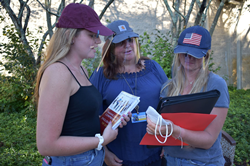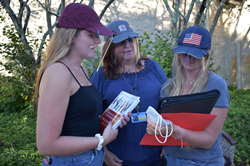
Cap Guard face shields facilitate clear and effective communication.
“We are missing a vital component of communication when our faces are hidden. Have you ever misunderstood a text because you were missing the emotion it was sent with?” Dr. Lisa Rose Johnson Ed. D.
CHICAGO (PRWEB)
October 07, 2020
Developed to allow people to interface safely and clearly, the patent pending Cap Guard face shield provides hygienic barrier protection while permitting visibility of facial expressions and lip movement for effective communication. http://www.capguard.us
Many educators struggle to teach effectively wearing a mask, and most students find wearing a mask all day to be uncomfortable lending to increased face touching which puts them at further risk. In addition, communication between teacher and student can be difficult. Dr. Lisa Rose Johnson Ed.D. is the Teacher Education SIG Representative for New Jersey Teachers of English to Speakers of Other Languages/New Jersey Bilingual Educators (NJTESOL/NJBE), “It is difficult to assess students when they are wearing a mask. It is hard to see their mouth movements, and when they read aloud it is hard to hear what they are saying. This also makes it hard for students to learn from each other. As an ESL teacher it is important for the students to see how the sounds are made. Also, when students learn languages it is important to see how the teacher’s mouth moves. All students benefit from verbal and nonverbal communication and wearing a mask makes it hard to see this. Wearing a face shield would allow for safety for students to see teachers.”
As a School Solutions partner with the National School Superintendent’s Association (AASA), Cap Guard offers face shields to educators, students, and school communities across the country. Too often, the compromise when teacher and student get frustrated with communication is to pull down their masks. This is not a compromise. It’s an unacceptable risk which can be mitigated by the wearing of a face shield such as Cap Guard that will still offer protection and simultaneously allow for full face expression and lip movement visibility.
School-based Speech Language Pathologists also encounter the same degree of difficulty when assessing students and providing speech therapy. Masks make it difficult to communicate and evaluate how a student is making certain sounds. Some schools have instituted masks with clear cut outs around the mouth to aid Speech Language Pathologists, but there have been complaints of chafed faces, chapped lips, and mouth and cheek rashes. Stacy Fronner MS CCC-SLP is a school-based Speech Language Pathologist, “Some letters make very similar sounds. Masks decrease hearing acuity. I need to see a student’s mouth to determine if they have correct tongue or lip placement. The placement of the mouth, lips or tongue gives me visual cues as to how the student is producing the sound. It is important to note if a student who is having difficulty producing sounds correctly is groping (moving their mouth repeatedly trying to produce the correct sound). It is important to note if a student who stutters is opening their mouth with no sounds coming out.” Fronner continues, “Facial expressions are an important part of communication. It is our emotions that give meaning to our words. Those emotions are conveyed through facial expression, voice, and body posture. We are missing a vital component of communication when our faces are hidden. Have you ever misunderstood a text because you were missing the emotion it was sent with?”
Cap Guard supports the American Speech-Language-Hearing Association (ASHA) and is a proud sponsor of ASHA’s national conference, “Practical Solutions for Elementary Assessment, Treatment, and Collaboration,” for school-based Speech Language Pathologists. The online conference is active now and continues through October 10th.
Ideally, the most effective combination for maximum protection from COVID-19 transmission is wearing a mask and a shield combined with social distancing and proper hand hygiene, but this is not always functional. Educators and Speech Language Pathologists are having to work in less than ideal conditions with preventative measures varying from school to school. Some schools are set up for social distancing; others only have separation in the classrooms. Some schools allow the wearing of face shields; some schools only permit such in conjunction with wearing a mask. To further confuse the issue are the varying opinions on the efficacy of face shields put forth by the CDC, the Infectious Disease Society of America, the Children’s Hospital of Philadelphia, and a host of leading Epidemiologists and medical journals. A recent article in the Journal of the American Medical Association (JAMA) supported face shields for clearer communication with protection. “The use of a face shield is also a reminder to maintain social distancing, but allows visibility of facial expressions and lip movements for speech perception. … Face shields offer a number of advantages. While medical masks have limited durability and little potential for reprocessing, face shields can be reused indefinitely and are easily cleaned with soap and water, or common household disinfectants. They are comfortable to wear, protect the portals or viral entry, and reduce the potential for autoinoculation by preventing the wearer from touching their face.”
The Cap Guard face shield is one tool in an arsenal of PPE products and resonates well with Educators and school-based Speech Language Pathologists across the country. Cap Guard supports the National School Superintendent’s Association (AASA) and the American Speech-Language-Hearing Association (ASHA) and their efforts to make the 2020-2021 school year as safe and as productive as possible. Industry expert, Tim Bolton, VP-Sales for North American Plastics, “I’m a parent of school aged children myself, and all of us are trying to navigate through this school year. Cap Guard face shields are excellent tools in the school setting when full facial expressions and lip movement visibility are critical to the message being imparted. They also are of great additional benefit when used in conjunction with masks and following guidelines set forth by infectious disease experts.”
Cap Guard features:
- Adult and child sizes
- 100% recyclable and reusable,
- Easily sanitized with antibacterial soap and water
- Optically clear and scratch resistant lens
- Full facial coverage, protects eyes
- Facilitates effective verbal and non-verbal communication
- Full visibility of facial expressions and lip movement
- Less claustrophobic, eyeglasses less likely to fog
- Shield easily attaches to brim of cap or visor
- Provides maximum benefit when combined with a face mask
Cap Guard face shields are the clear choice of face covering alternatives as part of the overall strategy to reduce the transmission of COVID-19 in the community setting.
For further information, visit: http://www.capguard.us
Share article on social media or email:

